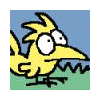Can you count 17,000 crows or 8 bald eagles in Pittsburgh?
Published in Outdoors
PITTSBURGH — Whether it's helping to count 17,000 crows, 3,636 starlings or eight bald eagles in Pittsburgh like last year, the 125th Annual Audubon Christmas Bird Count needs you.
This annual census of the birds, the world's longest-running citizen science project, has been a long tradition nationally, with Pittsburgh records dating back to 1914.
The Pittsburgh Audubon Christmas Bird Count (CBC) will continue its tradition of taking place on the Saturday following Christmas on Dec. 28.
The Bird Count continues to attract legions of volunteers: It's free, you learn something new, contribute to science and get outdoors for a respite from the holidays.
"The more eyes we have on a count, the more birds we will find," said Brian Shema, operations director of the Audubon Society of Western Pennsylvania and coordinator for the Pittsburgh CBC.
One volunteer counter, Sheree Daugherty, of Pittsburgh's North Side, has been participating for more than 20 years.
"It's something I enjoy. I love birding and being outdoors.
"The CBC gives me an opportunity to add to scientific data, so it's a win-win," she said.
Daugherty, past president of the Three Rivers Birding Club, is also an avian and nature artist. Her work includes birds commonly found during the CBC hand-painted on glass holiday ornaments.
There are more birds out there than you think.
Last year, the local Audubon Society hosted 185 volunteers who recorded 76 species of the more than 35,000 individual birds counted in Pittsburgh, Shema said.
"The idea of participating in the CDC might scare people who don't feel qualified. Anyone who wants to participate is welcome. We are good at pairing advanced and beginner birders," he said.
Earlier in the month, Audubon offered some bird count primer events for newcomers to learn more about their avian subjects and how the count works.
Over the years, volunteering has become more palatable. You can put in as little as one hour in the field or count the birds from the comfort of your home at your bird feeder.
There is even a special Bird Count for school-age kids at Audubon's headquarters at Beechwood Farms in Fox Chapel from 10 a.m. to noon on Dec. 28. An Audubon naturalist will guide the children, who must be accompanied by an adult and be pre-registered with Audubon.
The only limitations are geographic. Surveys occur in "count circles" with a 15-mile diameter. The Pittsburgh count's center point is in Shaler. And there are other count circles in Allegheny and surrounding counties.
The Bird Count was was hatched in 1900 as a humane alternative to the annual shooting of birds during the holidays. The Christmas Side Hunt was a pre-20th-century tradition featuring hunters trying to bag the largest pile of birds.
The effort grew into the world's longest-running citizen science project. Because there aren't enough biologists to survey a large swatch of land — the Bird Count is flush with volunteer birders.
CBC survey data has been used by numerous government agencies and nonprofits. For example, the U.S. Environmental Protection Agency included Audubon's CBC data as one of 26 indicators of climate change in their 2012 report, according to The National Audubon Society. CBC data also helped develop Audubon's Common Birds in Decline Report in 2007, which revealed that populations of some of America's most beloved birds have plummeted over the past 40 years.
To some, the Bird Count is somewhat of a sport, with communities and individuals vying to tally the most bird species. But it is much more than simply hunting the rarities. It's also about counting all the blue jays and juncos, as the number of birds considered common matter too.
"While the rarities are fun to find in winter, the common birds can act as a barometer as to what is happening to our wild bird population," Shema said.
"Tallies of our common birds help us understand if local populations are fluctuating and help map the ranges of our local birds."
The survey tracks bird population trends in our area.
Several decades ago, the red-bellied woodpecker was an uncommon species in the Pittsburgh region. It is now common because it expanded its range north from Southern states.
More recently, the Bird Count chronicled the burgeoning numbers of bald eagles in Pittsburgh.
Last year, eight bald eagles were tallied — the highest ever for the bird count in the city.
"The information gained from the bird count helps us understand the distribution and abundance of birds," Shema said.
"Compiling all bird count findings helps scientists understand where conservation efforts are best applied."
To volunteer for the Bird Count, contact your local count leader via the Audubon Society of Western Pennsylvania on its website or by calling (412) 963-6100.
(c)2024 the Pittsburgh Post-Gazette Distributed by Tribune Content Agency, LLC.







Comments